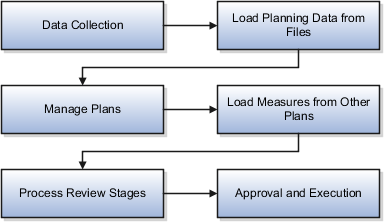Business Flows for Sales and Operations Planning
Use Sales and Operations Planning, a modern planning cloud solution, to manage your sales and operations planning process.
You can perform the following in the Sales and Operations Planning work area:
-
Process data collection and load planning data from external sources
-
Create and manage plans
-
Conduct the Product Review, Demand Review, Supply Review, Financial Review, and Executive Review stages
-
Automate a portion of the planning processes or run a subset of the processes
-
Analyze and adjust your data at any stage

Data Collection
Data collection is the first step of the planning business flow. You can collect and transform the data from various Oracle Fusion Cloud Supply Chain & Manufacturing (SCM) applications to the Supply Chain Planning repository. The data that you collect can be of three types:
-
Master data: Primarily sourced from Oracle Supply Chain Management Cloud.
-
Demand data: Two potential sources of demand data are:
-
Sales order data that flow from the Oracle Order Management Cloud.
-
Shipment history from the Oracle Materials Management Cloud.
-
-
Supply data: Supply data is collected from three sources:
-
Oracle Inventory Management Cloud
-
Oracle Manufacturing Cloud
-
Oracle Purchasing Cloud
-
Load Planning Data from Files
Apart from collecting data from an Oracle Fusion source system, you can also collect data from an external source system. Use the predefined collection templates (XLSM files) to collect data from an external source system.
Use these collection templates to collect bills of resources and planning measures data from external sources by using the file-based data import (FBDI) template: ScpBillOfResourcesImportTemplate.xlsm and ScpMeasuresImportTemplate.xlsm. Or, use the Create Bills of Resources scheduled process to automatically create bills of resources for planning assembly items in a sales and operations plan.
Manage Plans
In the Manage Plan stage, you create and manage sales and operations plans. You can create a plan and then define the plan based on your business requirement.
The Manage Plans page is for integrated plan management. The following are some of the tasks that you can perform from the Manage Plans page:
-
Create and define plans
-
Create a copy of existing plans
-
Open an existing plan
-
Run plans in batch mode
-
Perform data refresh on your plans
-
Approve plans
Load Measures from Other Plans
Loading measures from other plans is an optional step. If you have a valid supply plan, demand plan, or demand and supply plan, you can load measures from these plans to a sales and operations plan. The plans can be from the Demand Management, Supply Planning, Demand and Supply Planning, or Planning Central work area. For example, if the shipment forecast is managed in Demand Management or Planning Central, you can use the Load Measures from Other Plans task to load the shipment forecast in Sales and Operations Planning.
Process Review Stages
During the process review stages, you work with stakeholders to manage the product life cycle, balance demand and supply, and review the financial feasibility to execute the plan. The process review includes the following stages:
-
Product Review
-
Demand Review
-
Supply Review
-
Financial Review
-
Executive Review
Approval and Execution
In the approval and execution stage, you decide upon the best plan among alternative simulation plans using plan comparison. After you get an approval for the consensus operating plan from all stakeholders, you execute the plan in your tactical planning process.